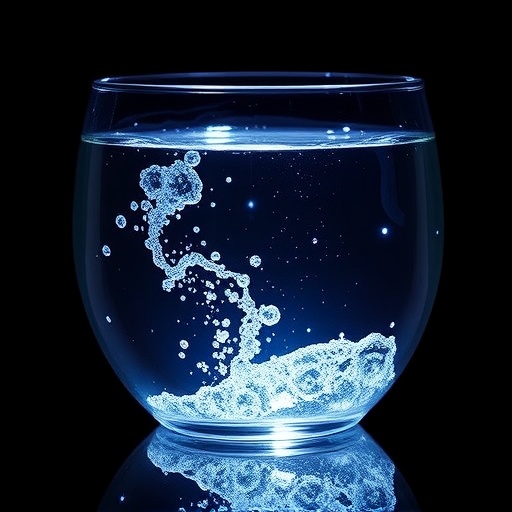In a groundbreaking advance in nonlinear optics, researchers at Japan’s Institute for Molecular Science and SOKENDAI have unveiled a revolutionary method to generate white light in water with unprecedented intensity. By employing non-harmonic two-color femtosecond laser excitation, this innovative approach achieves approximately a thousand-fold increase in broadband supercontinuum generation inside liquid water compared to conventional single-color techniques. This remarkable discovery marks a new frontier in ultrafast laser science and liquid photonics, providing a foundation for transformative developments in biological imaging, aqueous-phase spectroscopy, and attosecond-scale studies.
The research leverages the concept of two laser pulses operating at different wavelengths that do not share an integer frequency relationship. Unlike harmonic excitation where frequencies are integer multiples (such as fundamental and second-harmonic generation), this non-harmonic scheme introduces a novel regime of light-matter interactions that dramatically enhances nonlinear optical phenomena within water. Specifically, the researchers combined ultrashort femtosecond pulses centered at 1036 nm with a seed wavelength around 1300 nm, breaking conventional harmonic symmetry to induce new physical effects.
Focusing these two temporally overlapped pulses into water, the team exploited a synergy of nonlinear processes including soliton compression, dispersive-wave emission, four-wave mixing, and cross-phase modulation. These cooperative mechanisms collectively amplify the spectral broadening of the initial lasers, generating a supercontinuum—a broadband “white light” that spans a wide range of wavelengths and is vital for applications requiring ultrafast temporal resolution. The magnitude of the enhancement, about 1,000 times stronger than single-color setups, highlights the profound impact of non-harmonic excitation on water’s nonlinear optical response.
A key insight emerged from comparative experiments conducted using heavy water (D₂O), which did not exhibit the same dramatic enhancement. This finding underscores that the effect is intricately linked to the intrinsic dispersion and resonance characteristics unique to ordinary water (H₂O). These material-specific optical properties modulate how the non-harmonic pulse pairs interact and evolve as they propagate, enabling unprecedented control over light generation within the medium. It further reveals fundamental distinctions in photonic behavior between isotopologues of water.
Dr. Tsuneto Kanai, the lead scientist of the study, explained that deliberately breaking away from traditional harmonic laser frequency conventions unlocked unexpected regimes of ultrafast light amplification in liquids. This discovery not only challenges existing paradigms of laser-matter interactions but also introduces new pathways for enhancing light intensity and spectral coverage in aqueous environments. The newfound ability to harness such potent light sources inside water promises to propel advances across scientific disciplines dependent on high brightness and supercontinuum illumination.
Associate Professor Toshiki Sugimoto, principal investigator of the project, emphasized the wide-ranging implications of these findings. He noted that this novel optical approach could accelerate progress in probing electron dynamics at attosecond timescales within water, deep-tissue biophotonic imaging with improved penetration and resolution, and refined aqueous-phase spectroscopy that reveals interfacial and molecular behaviors with enhanced sensitivity. The versatility of this method offers broad utility across experimental science and emerging photonic technologies.
Fundamentally, the combined use of non-integer wavelength ratios to drive nonlinear interactions opens a new dimension in mode-locking and pulse shaping techniques applicable to liquids. This methodology extends the frontier beyond gas and solid-state systems, where harmonic excitations have predominated for decades, and situates water—the most universal solvent and biologically essential medium—as an enabling platform for ultrafast optics research. Through this paradigm shift, the research community gains a powerful tool to investigate and manipulate ultrafast light-matter phenomena in complex environments.
The exceptional intensity of the supercontinuum generated through this technique holds promise for generating coherent white-light sources with applications ranging from multiphoton microscopy to time-resolved spectroscopy. The ability to tailor light properties inside water also paves the way for developing compact, versatile laser sources that operate efficiently in aqueous and biological media without requiring complex external optics or nonlinear crystals typically utilized in solid-state systems.
Moreover, this discovery resonates deeply with the design of future nonlinear photonic devices that integrate liquids as active media, leveraging their unique dispersion and resonance profiles inaccessible in solids. The capacity to achieve high peak powers and broad spectral coverage in a controlled manner expands the toolkit for photonic sensing, nonlinear frequency conversion, and ultrafast optical signal processing. It may also inspire new experimental platforms targeting quantum optics phenomena and attosecond pulse generation in liquid environments.
This pioneering work was published as an Early Posting in Optics Letters on October 27, 2025, testifying to its immediate impact and relevance. The detailed experimental investigations and rigorous control studies underscore the robustness of the discovery and set the stage for extensive follow-up exploration. The research teams anticipate collaborative efforts to optimize excitation parameters, explore other liquid media, and exploit the technique for applied photonic systems and biomedical devices.
In summary, the dramatic enhancement of supercontinuum generation in water through non-harmonic two-color femtosecond laser excitation represents a paradigm shift in ultrafast optical science. By unlocking previously inaccessible nonlinear regimes within the world’s most ubiquitous liquid, this approach raises exciting possibilities for advancing the frontiers of photonics, spectroscopy, and biomedicine. As researchers continue to probe the intricate interactions between light and water enabled by this method, the scientific community stands poised for breakthroughs that harness the power of light in entirely new ways.
Subject of Research: Not applicable
Article Title: Dramatic Enhancement of Supercontinuum Generation in H₂O by Non-Harmonic Two-Color Excitation
News Publication Date: Not explicitly provided; original article posted on 27-Oct-2025
Web References: DOI: 10.1364/OL.575734
Image Credits: Institute for Molecular Science / Tsuneto Kanai
Keywords
Supercontinuum Generation, Non-Harmonic Laser Excitation, Femtosecond Lasers, Nonlinear Optics, Water Photonics, Two-Color Excitation, Ultrafast Spectroscopy, Soliton Compression, Dispersive-Wave Emission, Four-Wave Mixing, Cross-Phase Modulation, Biophotonics




